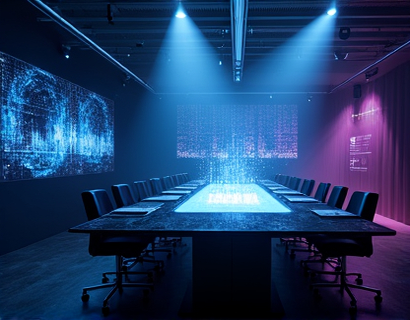Elevating Business Collaboration: Advanced Conferencing Solutions for Seamless Virtual Meetings
In the modern business landscape, the ability to collaborate effectively across distances is crucial for success. With the rise of remote work and global teams, traditional meeting methods are no longer sufficient. Advanced conferencing solutions have emerged to address these challenges, offering businesses a way to streamline communication and enhance teamwork, regardless of geographical boundaries. This article delves into the features and benefits of cutting-edge virtual collaboration platforms, designed to transform the way businesses interact and collaborate.
The need for advanced conferencing solutions is driven by the growing number of distributed teams and the demand for real-time collaboration. These solutions provide a comprehensive framework for virtual meetings, ensuring that teams can connect, share ideas, and work together seamlessly. The key to successful virtual collaboration lies in the platform's ability to offer intuitive interfaces, robust features, and reliable performance.
Seamless Virtual Meetings
One of the primary advantages of advanced conferencing solutions is their ability to facilitate seamless virtual meetings. These platforms are designed to minimize technical issues and ensure that participants can focus on the content of the meeting rather than the technology. High-definition video and clear audio are standard features, providing a professional and immersive experience.
Moreover, these platforms often include advanced noise cancellation and echo suppression technologies, ensuring that audio remains crisp and clear. Screen sharing, virtual whiteboards, and real-time document editing are just a few of the features that enhance the meeting experience. Participants can collaborate on documents in real-time, making the meeting more interactive and productive.
Intuitive User Interfaces
The user interface is a critical component of any conferencing solution. An intuitive design ensures that users of all technical backgrounds can navigate the platform with ease. This is particularly important for businesses with team members who may not be tech-savvy. A well-designed interface reduces the learning curve and allows users to focus on the meeting objectives.
Modern conferencing platforms often feature drag-and-drop functionality, customizable layouts, and simple navigation menus. These elements contribute to a user-friendly experience, making it easier for teams to set up and manage meetings. Additionally, many platforms offer mobile apps, allowing users to join meetings on-the-go and stay connected regardless of their location.
Robust Features for Enhanced Collaboration
Beyond basic video and audio capabilities, advanced conferencing solutions come packed with features that significantly enhance collaboration. One such feature is the ability to integrate with other business tools and software. This integration allows for a more cohesive workflow, where data can be shared and accessed seamlessly across different platforms.
For instance, calendars can be synchronized to automatically create meeting invitations and send reminders. Project management tools can be linked to allow for real-time updates and task assignments during meetings. This integration not only saves time but also ensures that all team members are on the same page.
Another valuable feature is the ability to record meetings. This functionality is essential for teams that cannot attend every meeting in person or for those who need to review important discussions later. Recorded meetings can be easily shared and accessed, ensuring that no critical information is missed.
Boosting Productivity and Connectivity
The primary goal of advanced conferencing solutions is to boost productivity and connectivity for teams worldwide. By providing a reliable and efficient platform for virtual meetings, these solutions help reduce the time and costs associated with travel. Teams can hold meetings with participants from different locations without the need for physical travel, thereby saving time and resources.
Furthermore, these platforms foster a sense of unity and collaboration among team members, regardless of their physical location. Regular virtual check-ins and team meetings can help maintain a strong company culture and ensure that everyone feels connected and engaged. This is particularly important for remote teams that may struggle with feelings of isolation.
Scalability and Flexibility
Advanced conferencing solutions are designed to scale with the growth of the business. Whether a company has a small team or thousands of employees across multiple regions, the platform can accommodate varying needs. This scalability ensures that the solution remains relevant and effective as the business evolves.
Flexibility is another key aspect. These platforms often offer a range of meeting types, from one-on-one calls to large-scale webinars. The ability to switch between different formats and adjust settings based on the meeting's requirements provides the necessary adaptability for various collaboration scenarios.
Security and Compliance
In an era where data security is a top priority, advanced conferencing solutions must adhere to strict security standards. These platforms typically implement robust encryption protocols to protect data during transmission and at rest. Compliance with industry regulations, such as GDPR and HIPAA, ensures that sensitive information is handled securely.
Additionally, many platforms offer features like password protection, waiting rooms, and participant controls to enhance security. These measures help prevent unauthorized access and ensure that meetings remain private and secure.
Enhancing Remote Work Experiences
The shift to remote work has underscored the importance of reliable communication tools. Advanced conferencing solutions play a pivotal role in enhancing the remote work experience by providing a professional and efficient way to connect with colleagues. These tools help bridge the gap between in-office and remote work environments, ensuring that all team members have equal opportunities to contribute and succeed.
Features like virtual break rooms and social spaces can also foster a sense of community among remote workers. These spaces allow team members to interact informally, building relationships and improving team dynamics. By simulating the social aspects of an office environment, these platforms help mitigate the isolation often associated with remote work.
Future Trends in Conferencing Technology
As technology continues to evolve, so too will conferencing solutions. One emerging trend is the integration of artificial intelligence (AI) to enhance the meeting experience. AI can assist with tasks such as automatic transcription, real-time translation, and even sentiment analysis to gauge the mood and engagement of participants.
Another area of development is the use of augmented reality (AR) and virtual reality (VR) in meetings. These technologies have the potential to create more immersive and interactive environments, allowing participants to feel as if they are in the same physical space. While these advancements are still in the early stages, they hold promise for the future of virtual collaboration.
Conclusion
Advanced conferencing solutions are revolutionizing the way businesses collaborate and communicate. By offering seamless virtual meetings, intuitive interfaces, and powerful features, these platforms are transforming the remote work experience. As businesses continue to embrace digital transformation, the importance of robust and flexible conferencing tools cannot be overstated. Investing in a high-quality virtual collaboration platform is not just a convenience; it is a strategic move to enhance productivity, connectivity, and overall business success.










































